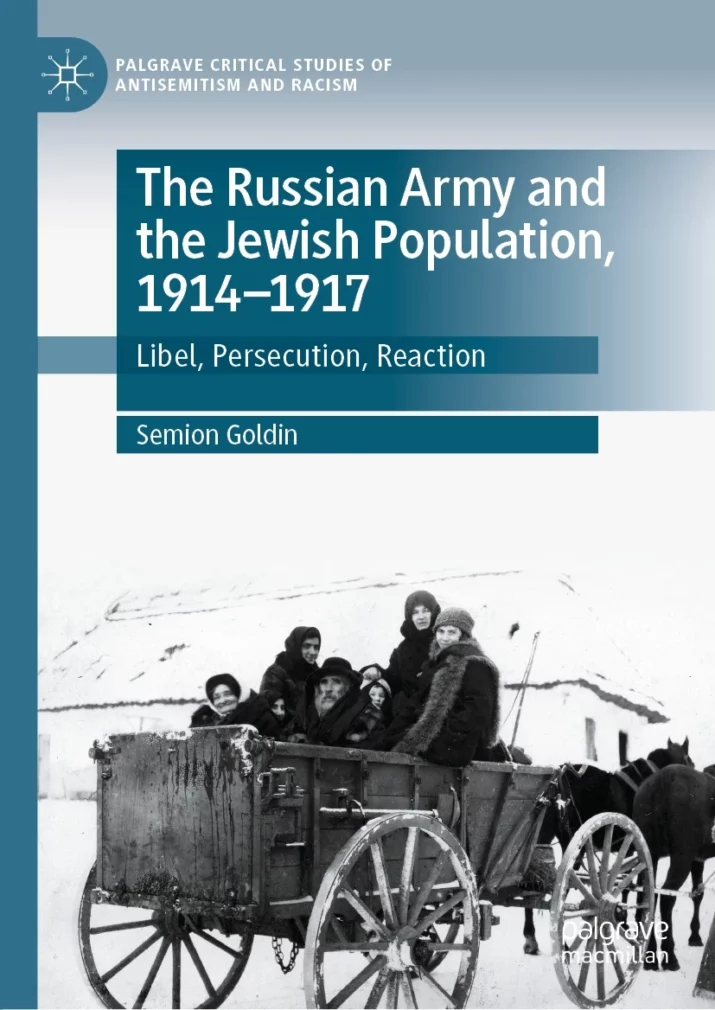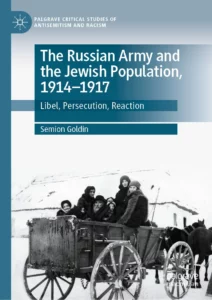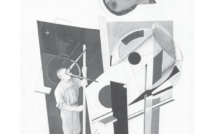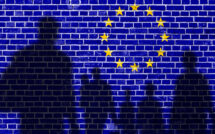
The Russian Army and the Jewish Population, 1914–1917: Libel, Persecution, Reaction by Semion Goldin

The connection between total war, modernity, the politics of ethnicity, strategies of governance, state building, and state collapse in Eastern Europe—and in particular in the Russian Empire—during the Great War has been at the core of several outstanding scholarly contributions published in the last two decades. Historians Peter Holquist, Eric Lohr, and Joshua Sanborn, among others, reconceptualized the relation between radical exclusionary nationalism, large-scale societal mobilization, widespread violence, and ostensibly modern views of collective identities. These authors emphasized the hardening of categories used by the state bureaucracy to define, classify, and assess the loyalty of the population. During WWI, ethnicity thus was applied as a fundamental criterion to identify and perceive an individual’s or a group’s essential features—consequently to ascribe a certain place for this individual or group within increasingly rigid hierarchies. However, ethnic identification also became a matter of sheer physical security and survival during times of upheaval and violent conflict. Perhaps in no other instance was this shift as clearly visible as in the case of the Russian Empire’s Jewish population. Aside from living under a highly restrictive and discriminatory legal regime, the Russian Jewry fell victim to the Russian army’s unrelenting hostility and persecution during the initial phase of WWI. Semion Goldin’s work builds on previous scholarship addressing the wartime Russian Empire but also nuances and revises some of the conclusions previously reached about the Russian Jewish population. This richly researched and thoroughly documented book seeks to integrate—and largely succeeds in this endeavor—“four separate disciplines that are infrequently studied together: Jewish history, Russian history, military history, and the history of antisemitism” (4). Based on an impressive array of sources (ranging from archival documents from various Russian, Ukrainian, Polish, and Israeli collections to the contemporary press, memoir literature, and previously unpublished documentary materials), this volume is “an expanded and considerably revised version” (viii) of the author’s previous Russian-language monograph, published in 2018.
The author structures his book into nine chapters, including an introduction, seven substantive sections in which he discusses various aspects of the Russian military’s perceptions of, attitude towards, and policies directed at the Jewish community of the Russian Empire during the first stage of WWI, and a concluding chapter. Goldin thus examines the increasingly hostile ways in which the Russian military establishment perceived the Jewish community in the early twentieth century, the emergence of the “negative stereotype of the Jew” in Russian military circles, and the conflict-ridden and difficult relationship between the army command and the civilian administration after August 1914. He devotes significant attention to the political implications of the “Jewish Question” and to the agency of the Jewish community’s leaders, displayed in the latter’s (ultimately futile) attempts to alert the central authorities to the army’s harshly repressive anti-Jewish policies, thus attempting to mitigate these policies’ disastrous consequences. The most densely written and factually rich chapters—the core of the author’s research—tackle the main repressive and exclusionary policies targeting the Jewish community, including mass deportations and expulsions, hostage taking, and various punitive measures applied by the army command in the front zone. For example, some cases of espionage were judged in military courts, and there were instances of administrative expulsions of suspect individuals, severe military censorship regulations, bans on the movement of Jews, and restrictions on their participation in voluntary societal initiatives. Goldin also extensively discusses—his work being truly pioneering in this regard—the frequent occurrences of arbitrary and extreme brutality perpetrated by Russian troops against the Jews; for example, there were widespread cases of pillaging and looting, pogroms, on-the-spot executions, and outrageous instances of sexual violence. Last but not least, the author also touches upon the role of the Jews’ “neighbors”—mostly peasants from nearby rural areas—in the mass violence; this topic links his work to the current debates about the significance of this category of perpetrators, mostly in connection to events usually associated with WWII and the Holocaust.
The subchapter on the fraught relations between the Jewish and non-Jewish population in the frontal zone during wartime points to what is, I believe, a central thesis of Goldin’s book, i.e., that the anti-Jewish policy of the Russian authorities was a direct and accurate, if extreme, reflection of “the systemic crisis of the Russian Empire in its final years” (263). The author rightly emphasizes “four manifestations” (263) of this deep crisis of Russian statehood, which were acted out between 1914 and 1917 in an escalating dramatic crescendo constituting a catastrophic self-fulfilling prophecy:
- the anti-Jewish policy undermined the Russian war effort and destabilized the rear;
- the system of military rule in the frontal zone proved to be starkly incompetent and arbitrary, weakening the state instead of strengthening it;
- the generalized violence at the front led to the collapse of the state’s monopoly on legitimate force (thus inadvertently preparing the ground for the Civil War); and
- the importance of the personal factor was, in itself, a symptom of the systemic crisis (263-265).
Although one can disagree with the author, in particular concerning this last point, one can hardly dispute his general contention that “the Russian military elite themselves set the stage for revolution and civil war” (266). I would add to this essentially convincing picture that the author should have addressed more forcefully the accelerating and radicalizing impact of wartime violence, as he seems to acknowledge when asserting that “the wave of violence… ‘washed away’ the prewar stable relations between Jews and non-Jews” (210).
One of the underlying conceptual contributions of Goldin’s approach addresses the nature and coherence of the Russian army command’s “Jewish policy” between 1914 and 1917. The author repeatedly—and, for the most part, successfully—attempts to steer a “middle course” between the radical historiographical position epitomized, for instance, by Mark Levene, who posits that the anti-Jewish persecution initiated by the Russian military was “sub-genocidal” (9), and the excessively cautious interpretation of Yohanan Petrovsky-Shtern, who—somewhat counterintuitively—characterizes the position of the Russian high command (at least before WWI) as “moderately conservative” (253). Goldin reinforces his rejection of the “genocide” label when assessing the wartime developments in the Russian Empire by concluding that he found no evidence of any plans to physically annihilate the Jews living in the war zone (“the Russian command [never] contemplated mass physical annihilation of the Jews,” 257). At the same time, the author does highlight the fact that “[t]he army, evidently, had stronger anti-Jewish feelings than the rest of society” (253; the same idea is expressed on 96). Goldin is, however, walking a fine (definitional) line here. His rejection and avoidance of the highly charged (and politically infused) notion of genocide is certainly commendable. Moreover, I share his view that, in the decades preceding the 1914 conflagration, a clear tendency to ethnicize and racialize the Jews was discernible in Russia (24-25, 96, 254). These shifts certainly account for the radicalization of the military elite’s perceptions and policies aimed at the Jewish community after 1914.
While not amounting to a full-fledged genocidal project, the intensity of the Russian military’s anti-Jewish worldview was, nevertheless, unprecedented in the contemporary European context. The author himself labels the anti-Jewish policies of the military authorities as a “war against the Jews.” He thus points to the ostensibly all-encompassing and uncompromising character of this campaign against an element of the population perceived as harmful, untrustworthy, and inimical to the Russian majority. He also admits that the extreme violence perpetrated by the troops “diverged sharply from the European norm” and, moreover, that “Russia… surpasse[d] other European states in the scale and acuity of the army’s measures against Russian Jews (9).” This position begs one question: how unique or specific was Russia, in this regard, in comparison with other European and Eurasian empires? And, consequently, how peculiar was the tragic experience of its Jewish population? Goldin is careful to introduce a welcome comparative dimension into his examination of the Russian Jewish case. Thus, he makes insightful parallels with the (almost contemporary) Armenian genocide in the Ottoman Empire and with the Habsburg monarchy’s superficially similar targeting of its own (“untrustworthy”) subjects. Still more relevant is the author’s comparison of the Jewish case with the plight of the ethnic Germans—the other significant category of domestic “enemy aliens” (Lohr 2003) within the Romanov polity—whose fate is deemed by Goldin to be actually worse that the suffering of the Jewish community (105, 111, esp. 177). Thus, the tragedy of the Jews is not unique—whether domestically or internationally—but the combination of factors resulting in the “scapegoating” of the Russian Jewish population certainly is.
Another fundamental and controversial point stemming from Goldin’s analysis relates to the coherence and consistency of the Russian military authorities’ anti-Jewish policy. Distancing himself from Eric Lohr, who interpreted the anti-Jewish and anti-German campaigns as two sides of the same coin, and deriving from the exclusionary vision of “war nationalism,” Goldin insists that the civilian authorities sought to restrain the military in their anti-Jewish fervor, in contrast to the Germans’ case, which, conversely, became “an important arena of state policy” (261). Goldin also rejects Peter Holquist’s thesis that the anti-Jewish campaign resulted from “a targeted, systemic, and far-reaching antisemitic program” (258). Indeed, one of the author’s crucial arguments is that the Russian military’s policies were unplanned, chaotic, ill-conceived, inconsistent, and unfocused. However, I think Goldin goes a bit too far here. First, there is no essential contradiction between the incoherence of Russian state policy, as displayed in the constant rivalry and internal conflicts between various branches of government, and the far-reaching “ideological goals” of the Russian military (259). Second—as alluded to above—I think Goldin misinterprets the role of the personal factor in this story of escalating violence. Far from being simply a symptom of the statewide “systemic crisis”—which it undeniably is—that role is also, as Holquist correctly implies, a constitutive feature of the workings of the Russian state machine throughout the imperial period. As the author himself acknowledges, figures such as General Nikolai Yanushkevich and Valerian Muraviev (whose “insignificant” memorandum gave the impetus for the circular of 22 January 1915—a “turning point” (255), in Goldin’s own words—was paramount in the paroxysm of repression and violence that followed. Rather than being an aberration caused by the worsening crisis, these were, however, revealing examples of how autocracy worked (a fact confirmed by the personal support of the emperor, which was a crucial factor in both cases).
Finally, the question raised by the author—to what extent is the violence unleashed in 1914-1915 in the Russian Empire’s borderlands a “prologue” to the Holocaust? (12)—represents a seminal subject for further discussion. One can fully endorse the author’s conclusion that this period was no direct precedent for Nazi policies during WWII. However, as Goldin himself hints on another occasion, “the monstrous anti-Jewish violence of 1918-1920” was “a direct continuation and culmination of the events of 1914-1915” (263). Thus, while it would be wrong to posit any direct continuities—ideological or otherwise—between the two world wars, the incremental character of the violence in the borderlands should be noted and taken seriously. As should the unsavory role of various state actors in fomenting, condoning, and inciting violence.
Due to lack of space, I do not touch upon a whole array of other relevant points raised by Goldin, notably on the potential redefining of antisemitism as a concept, the importance of Jewish social history and everyday experience during wartime, or the recuperating of the victims’ voices (and of their too often overlooked agency). To conclude, Semion Goldin’s work on the Russian Jewish community and the imperial army during WWI is a fascinating foray into the Russian Jewry’s impossible conundrum between “libel, persecution, and reaction” and into its traumatic, violent, chaotic, and complex encounter with the dark side of modernity. This work will surely remain the definitive treatment of the subject for some time to come.
Andrei Cusco has been a researcher at the Institute of History of the Romanian Academy in Iași, Romania since 2021. He holds an MA (2002) and a PhD degree (2008) from the Department of History of the Central European University (CEU) in Budapest. He co-edited six collective volumes and authored over fifty scholarly articles or book chapters and two monographs, including A Contested Borderland: Competing Russian and Romanian Visions of Bessarabia in the Late 19th and Early 20th Century (CEU Press, October 2017).
References
Holquist, Peter. 2001. “To Count, to Extract, To Exterminate: Population Statistics and Population Politics in Late Imperial and Soviet Russia.” In A State of Nations: Empire and Nation-Making in the Age of Lenin and Stalin, edited by Terry Martin and Ronald G. Suny, 111-144. New York: Oxford University Press.
Holquist, Peter. 2010. “The Role of Personality in the First (1914 – 1915) Russian Occupation of Galicia and Bukovina.” In Anti-Jewish Violence: Rethinking the Pogrom in East European History, edited by Jonathan Dekel-Chen, David Gaunt, Natan M. Meir, and Israel Bartal, 52-73. Bloomington: Indiana University Press.
Lohr, Eric. 2003. Nationalizing the Russian Empire: The Campaign against Enemy Aliens During World War I. Cambridge, MA: Harvard University Press.
Sanborn, Joshua A. 2014. Imperial Apocalypse: The Great War and the Destruction of the Russian Empire. New York: Oxford University Press.
The Russian Army and the Jewish Population, 1914–1917: Libel, Persecution, Reaction
By Semion Goldin
Publisher: Palgrave Macmillan
Hardcover / xx + 305 pages / 2022
ISBN: 978-3-030-99787-8
Published on May 1, 2023




